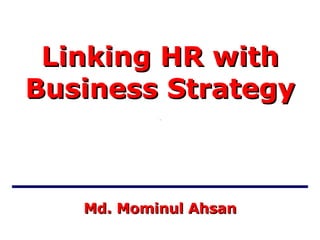Hr With Business Strategy 1
•
57 recomendaciones•15,176 vistas
Denunciar
Compartir
Denunciar
Compartir

Recomendados
Más contenido relacionado
La actualidad más candente
La actualidad más candente (20)
Strategic Human Resource Management (SHRM) - MBA 423 Human Resources Manageme...

Strategic Human Resource Management (SHRM) - MBA 423 Human Resources Manageme...
Types of hr strategies - strategic human resource management - Manu melwin joy

Types of hr strategies - strategic human resource management - Manu melwin joy
Destacado
Destacado (10)
Importance Of Aligning Human Resources With Strategy

Importance Of Aligning Human Resources With Strategy
HR Strategy - How to develop and deploy your hrm strategy - a manual for HR ...

HR Strategy - How to develop and deploy your hrm strategy - a manual for HR ...
Similar a Hr With Business Strategy 1
Similar a Hr With Business Strategy 1 (20)
BBA-SEM-3-HRM-Introduction of Human Resource of Management 

BBA-SEM-3-HRM-Introduction of Human Resource of Management
Transformation Of HR at AgustaWestland-Philadelphia

Transformation Of HR at AgustaWestland-Philadelphia
Developing a winning strategy for hr in 2021 final

Developing a winning strategy for hr in 2021 final
1Are We There YetWhat’s Next for HRDave UlrichProfe.docx

1Are We There YetWhat’s Next for HRDave UlrichProfe.docx
Class #3 Systematic Design of HRD ProgramsThe Purpo.docx

Class #3 Systematic Design of HRD ProgramsThe Purpo.docx
Último
Último (20)
MAHA Global and IPR: Do Actions Speak Louder Than Words?

MAHA Global and IPR: Do Actions Speak Louder Than Words?
Independent Call Girls Andheri Nightlaila 9967584737

Independent Call Girls Andheri Nightlaila 9967584737
Call Us 📲8800102216📞 Call Girls In DLF City Gurgaon

Call Us 📲8800102216📞 Call Girls In DLF City Gurgaon
Church Building Grants To Assist With New Construction, Additions, And Restor...

Church Building Grants To Assist With New Construction, Additions, And Restor...
8447779800, Low rate Call girls in New Ashok Nagar Delhi NCR

8447779800, Low rate Call girls in New Ashok Nagar Delhi NCR
Kenya Coconut Production Presentation by Dr. Lalith Perera

Kenya Coconut Production Presentation by Dr. Lalith Perera
Appkodes Tinder Clone Script with Customisable Solutions.pptx

Appkodes Tinder Clone Script with Customisable Solutions.pptx
Pitch Deck Teardown: Geodesic.Life's $500k Pre-seed deck

Pitch Deck Teardown: Geodesic.Life's $500k Pre-seed deck
International Business Environments and Operations 16th Global Edition test b...

International Business Environments and Operations 16th Global Edition test b...
Memorándum de Entendimiento (MoU) entre Codelco y SQM

Memorándum de Entendimiento (MoU) entre Codelco y SQM
Unlocking the Future: Explore Web 3.0 Workshop to Start Earning Today!

Unlocking the Future: Explore Web 3.0 Workshop to Start Earning Today!
FULL ENJOY Call girls in Paharganj Delhi | 8377087607

FULL ENJOY Call girls in Paharganj Delhi | 8377087607
8447779800, Low rate Call girls in Kotla Mubarakpur Delhi NCR

8447779800, Low rate Call girls in Kotla Mubarakpur Delhi NCR
8447779800, Low rate Call girls in Saket Delhi NCR

8447779800, Low rate Call girls in Saket Delhi NCR
Hr With Business Strategy 1
- 1. Md. Mominul Ahsan Linking HR with Business Strategy
- 7. HR as an administrative function vs. HR as a strategic partner capable of enhancing the organization’s performance WHAT DOES HR STRATEGIC ALIGNMENT MEAN?
- 16. Aligning Business Strategy & Talent Strategy Implementing an organization’s business strategy requires people who consistently demonstrate the talents that embody the knowledge, skills and traits required to achieve high performance. Business Strategy Talent Strategy How will our organization be positioned in the marketplace? Who are our core customers and our competitors? What is our unique value proposition? How will we create value for our customers, employees and owners? What will drive organizational performance and create exceptional results? What talents are required in our people to deliver our critical capabilities and achieve our performance goals? How will we define success? How will we know when performance meets customer, employee and owner expectations? What resources are required to develop the talent necessary to achieve our business strategy? Critical Capabilities Performance Competencies Performance Measures
- 36. Challenges facing Human Resources De-motivated Workforce Damage to Company Image Loss of Business Low Customer Satisfaction High Employee Turnover Low Productivity
- 38. HR IN A NUTSHELL: 06/10/09
- 42. Thank You
